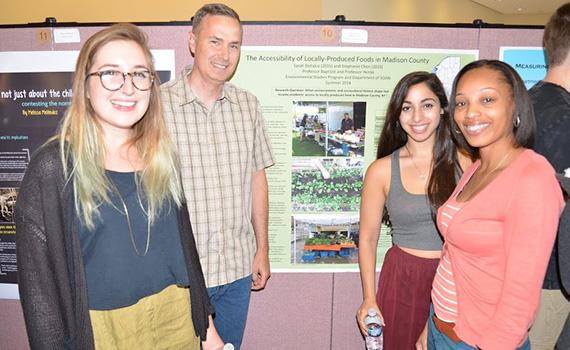Turns out, it’s more affordable than you would think to be a “locavore” (eating locally produced food), at least in Madison County. This observation is based on preliminary research findings by Professor Christopher Henke, Professor April Baptiste, Stephanie Chen ’16, and Sarah DeFalco ’15.
The group gave a presentation titled “Can Everyone Be a Locavore? Food Access for Low-Income Residents of Madison County” at the Hamilton Public Library on Tuesday, November 18.
Despite common misperceptions, locally produced foods are priced competitively with similar foods sold at supermarkets, the group found. But, there are certain barriers stopping low-income residents from accessing local food options, which ultimately need to be addressed.
The research investigates the cultural and economic factors that prevent low-income residents from becoming locavores — and how to overcome those hurdles. Research methods included comparing the pricing of produce and eggs at several area supermarkets, farmers’ markets, and farm stands.
“One of the most challenging aspects of our process was finding our boundaries,” Chen said. “These included what we would define as low-income, what types of food items to price, what food venues to focus on, what we consider to be local, and where to conduct our interviews.”
The team conducted 23 interviews with food producers, regional community partners, and Madison County residents. For example, they asked Hamilton Food Cupboard interviewees what they liked about locavorism and about barriers they believed were stopping them from eating locally.
Common responses were that local food would be fresher, but also more expensive. Limitations — some real, some misperceived — included transportation, food preferences, the convenience of being able to buy all your goods in one place, inability to use alternate payments like SNAP benefits, and affordability.
“What surprised me most about our research findings was that farmers’ market and farm stand produce prices were competitive, and often cheaper, than supermarket prices,” said DeFalco.
The library presentation was attended by residents and Colgate students, as well as community partners including local farmer Jim Wrobel ’79, representatives from the Food Bank of Central New York, Colgate’s Upstate Institute, and Common Thread CSA.
“The comments pertaining to how we might move forward with the research were particularly helpful,” Baptiste said. “[For example,] Rebecca from the Food Bank of Central New York indicated that a second round of interviews would be particularly helpful to understand the demand for local produce and fruits among low-income residents.”

